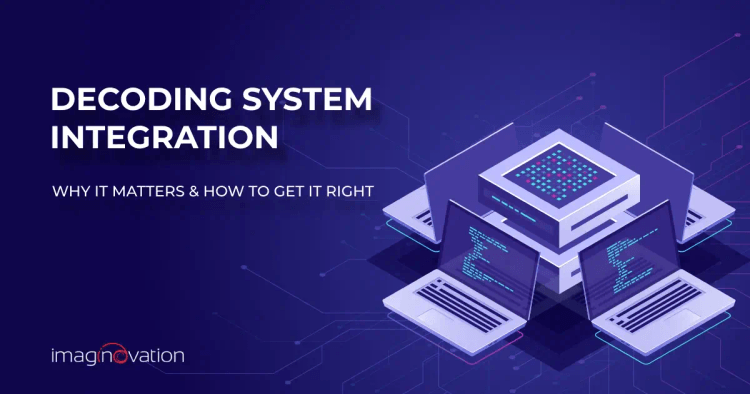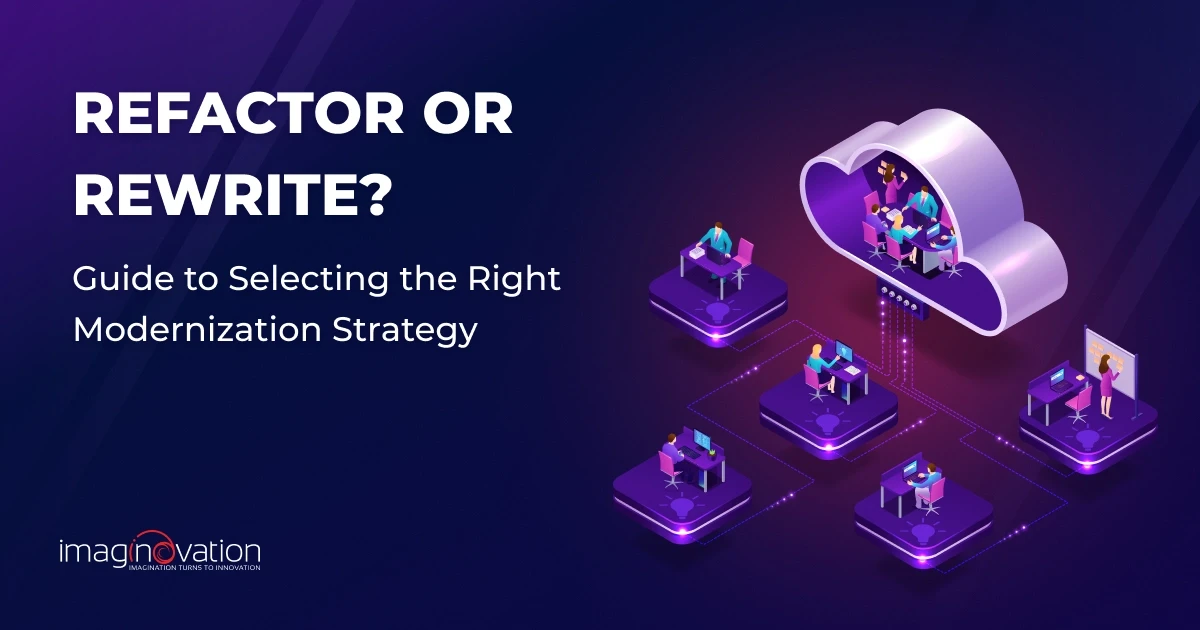Have you ever wondered how different software applications and systems work together seamlessly like a well-coordinated team?
Well, it all boils down to the art of system integration.
In this blog, we will decode what is system integration, unravel its importance, and understand why it matters for businesses of all sizes.
From reducing operational chaos to boosting productivity, system integration holds the key to unlocking the full potential of your organization.
We will share tips, tricks, and best practices on how to get system integration right.
So read on as we share the secrets of system integration mastery!
What is System Integration?
System integration refers to the process of seamlessly combining multiple software applications, business systems, databases, and various technologies into a unified and cohesive functioning unit.
The primary objective of system integration is to enable these systems to share information and work together harmoniously.
By integrating these systems, businesses can achieve several benefits, including improved communication, streamlined operations, and increased efficiency. It's akin to ensuring that all the components of a machine fit together perfectly and operate seamlessly.
System integration ultimately helps organizations save time, reduce errors, and enhance overall performance.
This integration encompasses a range of systems, including legacy systems, third-party and enterprise applications, B2B environments, web services, apps, and other data interchange solutions.
Whether these systems are on-premises or in the cloud, system integration allows organizations to connect them effectively.
And once these systems are successfully connected, you can automate various business processes, such as data exchanges, workflows, or reporting procedures.
Also Read: Large Scale Systems Design - Architecture for Massive Scale
Key Benefits of System Integration
In today's business landscape, organizations rely on a variety of applications to meet their needs.
However, these applications and systems often operate in isolation, requiring employees to transfer data between them manually.
The solution in this case is clear - integrate these disparate systems.
Through system integration, businesses can streamline operations and eradicate the need for manual data transfer, leading to enhanced efficiency and productivity.
System integration offers numerous other advantages for businesses and organizations.
Let's explore the key benefits of integrating various software applications, systems, and technologies.
1. Enhanced data accuracy
When data is duplicated across separate, unrelated systems, its accuracy decreases.
To make informed decisions, it's essential to have accurate and consistent data.
Using disconnected software for generating reports may result in outdated or incorrect information.
However, by integrating these systems, you can significantly reduce the likelihood of human errors and maintain data accuracy, ultimately supporting informed decision-making.
2. Improved data security
System integration can contribute to improved data security through centralized security measures, streamlined processes, and enhanced monitoring capabilities.
For example, using applications like spreadsheets for gathering data poses security risks, as security measures such as password protection can be easily bypassed.
Integrated systems eliminate the use of spreadsheets by securely collecting sensitive information into a secure database.
3. Better data access mechanism
System integration combines data silos and provides better access to information by simplifying connections between systems.
It eliminates manual processes, improves data retrieval and sharing, and offers a comprehensive view of the organization's data landscape.
This saves time and avoids the nightmare of searching for documents and information across multiple systems.
4. Enhanced sales volume
System integration automates processes, eliminates manual tasks, ensures data accuracy, and provides real-time insights to boost sales volume.
Integration offers a unified view of customer data for targeted marketing and sales. Your sales teams can quickly respond to customer needs and market opportunities with real-time data access.
For instance, integrating the inventory management system with the sales system allows automatic real-time updates on product availability, leading to faster and enhanced sales volume.
5. Access to real-time data

System integration becomes a game-changer in industries where accurate, real-time data metrics are crucial.
By integrating systems, businesses gain enhanced agility and make smarter decisions by relying on up-to-date data.
Real-time data access also enables timely evaluations, facilitating faster responses and adjustments.
With seamless integration, businesses can use real-time data to stay competitive, identify trends, and seize opportunities proactively.
6. Cost savings
Saving money is a significant benefit of system integration. Custom-built strategies reduce costs by combining or linking systems.
Additionally, automating data transfer between systems helps businesses avoid expenses related to human errors and delays, further contributing to cost savings.
Moreover, this process enhances productivity and decision-making by providing more accurate data access, which also leads to cost savings.
7. Fewer bottlenecks
Inefficient systems cause more delays and hinder large organizations' ability to act quickly. Integrated systems, on the other hand, remove these obstacles, leading to greater efficiency.
System integration leads to fewer bottlenecks because it connects different parts of an organization's infrastructure, allowing data and processes to flow more smoothly and efficiently.
Common Challenges of System Integration
System integration, though not inherently complex, presents several challenges for organizations.
From incompatible systems and data inconsistencies to technical complexities and resource requirements, navigating these hurdles can be overwhelming for businesses.
Let’s discuss some of the common challenges of system integration.
1. Ever-changing integration landscape
The constantly changing integration landscape demands adaptable system integration strategies and systems to keep pace with evolving technologies and standards.
Neglecting this adaptability can lead to compatibility issues, inefficiencies, and higher risks, underscoring the need for flexible integration efforts.
The longer any project lasts, the more severe this problem grows. To mitigate this risk, time and action are key.
Shortening integration projects increases the chances of success.
In addition, an agile approach, capable of adapting to evolving requirements during and after the project, is vital for successful systems integration.
2. Legacy systems

Older, legacy systems are vital for business operations and not easily replaced.
However, these systems present challenges for system integration due to their outdated technology, lack of vendor support, data format incompatibility, high integration costs, limited documentation, scarcity of skilled experts, and data migration complexities.
These factors make integrating legacy systems with modern ones a complex and resource-intensive endeavor.
3. Dealing with complexity and compatibility
System integration involves multiple levels (unit, component, subsystem, and system) with different methods and tools.
Compatibility issues arise from differing interfaces, protocols, standards, and dependencies.
A systematic approach with a defined strategy and test plan is crucial
to overcome this.
Consider applying an appropriate technique like top-down, bottom-up, or hybrid approaches to ensure smooth integration.
4. Data compatibility issues
Data compatibility is a critical challenge in system integration.
It's crucial to effectively utilize existing enterprise data to ensure business success.
Since various business units or departments have diverse operational responsibilities and use different systems or applications, data format discrepancies, and compatibility issues are very noticeable.
In this case, a systems integration must not only meet individual unit requirements but also provide a standardized view of data across the entire enterprise.
5. Ensuring a watertight integration planning
Lack of effective planning is a major reason why system integration projects fail. These projects often do not deliver the expected outcomes without sufficient research and forward planning.
To avoid chaos, thorough planning is necessary before embarking on an integration project.
It is important to determine the objectives, the purpose of the integration, the essential systems to be integrated, and the data that needs to be processed and managed.
6. Lack of expertise
Finding the expertise needed for system integration can be challenging.
Even with excellent integration technology, companies often struggle to hire and retain employees with the right skills.
To overcome this, a viable solution is to take the help of an external third-party provider. They can offer the required integration expertise and technology, ensuring successful integration projects.
7. Lack of accountability
Integrating many different subsystems in an organization can lead to unclear accountability for the integration's success.
With multiple stakeholders involved, each with their own focus and working independently, problems often result in a blame game instead of taking ownership.
However, when a single party manages the integration project, it eliminates any ambiguity in accountability.
How to Implement System Integration
Do you wish to integrate different systems within your organization?
Yes?
System integration demands careful planning.
In this section, we provide practical tips and advice on implementing system integration successfully.
The step-by-step approach will help you set the stage for a successful implementation.
Let’s get started!
1. Planning

System integration planning is the first step for ensuring the success of your integration project.
To begin this journey with confidence, it's essential that everyone involved comprehends the objectives and goals right from the start.
These objectives must align well with your business's overall automation strategy, primarily focusing on improving efficiency, enhancing performance, and fostering growth.
To accomplish this, gathering input from every employee and department that will rely on the integration and data management is essential.
This proactive approach guarantees that the right information is readily available to meet their specific requirements.
For a smooth system integration, consider the following key factors:
- Identify the specific business cases or problems that require resolution.
- Determine the data that must be accessed and managed during the integration process.
- Identify the processes that can be automated to improve efficiency.
- Set clear priority objectives for the integration project.
- Take into account any future requirements that may arise.
These objectives will not only guide the type of integration required but also help prioritize different project stages.
2. Analysis
Once you've set your objectives, the project team needs to look at your current setup: what systems, applications, and processes you already have and where your data resides. This helps figure out how to connect things and what to automate.
Consider these questions:
- What systems need to work together?
- Is it on-site to on-site or on-site to the cloud?
- Could it be a mix of both?
- Does it involve web services?
- Any old integrations to replace?
- Which tasks should be automated?
- How much data needs to be handled?
- What business rules are already applied?
Once you have these answers, your systems integrator, IT partner, tech partner or internal developer can provide recommendations on what's feasible, how long it will take, and an estimated cost.
3. Design

Once you've agreed on your goals and done a detailed analysis, your project team can choose the right integration solution.
This sets the stage for designing the architecture and mapping business processes.
You can use BPMN (business process model and notation) flowcharts to document these processes visually. These charts are easy for both tech and non-tech people to understand.
They're handy for mapping things like:
- Receiving orders from an eCommerce web store
- Approving expenses or discounts
- Handling customer support inquiries
- Placing orders with a supplier
- Sending out documents and reports
These charts also help make sure you follow business rules and spot any bottlenecks in advance.
So, these detailed blueprints are created to outline the design of how the different systems will come together and consolidate data during the integration process.
4. Management plan
This step offers a structured approach to managing resources, tasks, timelines, and potential risks.
It starts with a clear project overview, defining its purpose, objectives, and scope.
The project team is identified, with roles and responsibilities clearly delineated. A detailed project timeline with milestones and deadlines is created, and resources are allocated appropriately.
Potential risks and challenges are identified, and strategies to mitigate them are developed.
The management plan provides a well-structured framework for the project's effective coordination and execution from start to finish.
5. Implementation
After defining the management plan, the systems integrator or IT partner builds connections and automates business processes.
The time it takes depends on the type of integration chosen.
Manual integration can take months due to custom coding. But using middleware can cut that down to just a few weeks.
Before going live, rigorous testing for quality assurance is essential to ensure a seamless transition to automated processing.
6. Maintenance
One of the often forgotten steps is regular maintenance for system integrations.
You must do scheduled software checks to catch new errors and ensure things work well.
If there are issues, contact the IT team to fix problems or add new components.
Make sure to apply upgrades without disrupting your system connections or data flow – something manual integration can't promise.
And remember to have support and training in place, so your IT team can handle business processes on their own.
Implement Successful System Integration with Imaginovation
System integration delivers a strong ROI and a host of operational, strategic, and financial improvements. To maximize these benefits, choose an integration expert aligned with your business needs.
Imaginovation specializes in digital transformation and offers system integration solutions. Our expertise helps enhance workflows and business processes.
We help answer key integration questions:
- Your integration system options
- Best integration method for your business
- Impact on current systems
- Impact on future processes
Contact us for your integration needs and succeed in the digital age!
Ready to build an app, but not sure where to start?
We've got you covered. Click the button below to get started.





